Attached files
| file | filename |
|---|---|
| 8-K - FORM 8-K - GATX CORP | c66746e8vk.htm |

| GATX Corporation Company and Industry Profile March 2012 Unless otherwise noted, GATX is the source for data provided |

| NYSE: GMT Forward-Looking Statements This document contains statements that may constitute forward-looking statements within the meaning of Section 27A of the Securities Act of 1933 and Section 21E of the Securities Exchange Act of 1934 and are subject to the safe harbor provisions of those sections and the Private Securities Litigation Reform Act of 1995. Some of these statements may be identified by words like "anticipate," "believe," "estimate," "expect," "intend," "plan," "predict," "project" or other similar words. Investors are cautioned that any such forward-looking statements are not guarantees of future performance and involve risks and uncertainties, including those described in GATX's Annual Report on Form 10-K for the year ended December 31, 2011 and other filings with the SEC, and that actual results or developments may differ materially from those in the forward-looking statements. Specific factors that might cause actual results to differ from expectations include, but are not limited to, (1) general economic, market, regulatory and political conditions affecting the rail, marine and other industries served by GATX and its customers; (2) competitive factors in GATX's primary markets, including lease pricing and asset availability; (3) lease rates, utilization levels and operating costs in GATX's primary operating segments; (4) conditions in the capital markets or changes in GATX's credit ratings and financing costs; (5) risks related to compliance with, or changes to, laws, rules and regulations applicable to GATX and its rail, marine and other assets; (6) costs associated with maintenance initiatives; (7) operational and financial risks associated with long-term railcar purchase commitments; (8) changes in loss provision levels within GATX's portfolio; (9) conditions affecting certain assets, customers or regions where GATX has a large investment; (10) impaired asset charges that may result from changing market conditions or portfolio management decisions implemented by GATX; (11) opportunities for remarketing income; (12) labor relations with unions representing GATX employees; and (13) the outcome of pending or threatened litigation. Given these risks and uncertainties, readers are cautioned not to place undue reliance on these forward-looking statements, which reflect management's analysis, judgment, belief or expectation only as of the date hereof. GATX has based these forward-looking statements on information currently available and disclaims any intention or obligation to update or revise these forward-looking statements to reflect subsequent events or circumstances. 2 |

| GATX Corporation GATX Corporation strives to be recognized as the finest railcar leasing company in the world by: customers shareholders employees communities where we operate 3 |

| GATX Corporation History and Goals GATX has an impressive history Founded in 1898 as a railcar lessor Listed on NYSE in 1916 Initiated quarterly dividends in 1919 and paid without interruption ever since Recently increased 3.4% to $1.20 annualized Railcar leasing remains the foundation of GATX GATX mission: We earn a superior risk-adjusted return for our shareholders by providing our customers with the finest railcars, service and leases in the industry. 4 |

| (1) Portfolio Management (2) American Steamship Company See the Appendix for a reconciliation of non-GAAP measures Business Profile 5 $6.7 billion NBV (assets on and off balance sheet) as of 12/31/11 PM(1) 13% ASC(2) 4% Other 4% Operating Lease Assets 74% Joint Ventures 7% ASC(2) 4% Finance Leases 5% Transportation Assets 94% |

| 2011: Capitalized on the recovery in the rail market Increased lease rates Lease Price Index improved to 6.9% Grew the asset base Placed an order for 12,500 new railcars, the largest order in GATX's history Made progress in emerging markets Pursuing leasing license in India 6 2008 - 2010: Performed through the downturn Maintained high fleet utilization despite idle capacity in the industry North American fleet utilization never fell below 95.9% Controlled costs Reduced SG&A costs by almost 25% from the peak of the market Improved maintenance efficiency Grew the asset base Purchased railcar fleets from other lessors at advantaged prices Acquired an interest in nearly 12,000 railcars Performance |

| 2012 Environment Rail market fundamentals continue to improve GATX is focused on improving lease rates and extending lease terms in North American Rail Investment outlook is positive American Steamship Company expects increased demand during the 2012 navigation season 7 |

| Rail Industry |

| Rail Industry Railcars are owned by lessors, railroads and shippers 9 Source: Umler as of Jan-12 * Cars owned by TTX, representing about 9% of the total North American fleet, are included with Lessors Lessors* 56% Shippers 19% Approximately 1.6 million railcars |

| Rail Industry 10 Tank cars are owned by lessors such as GATX or shippers who utilize this car type Railroads do not have an ownership presence in tank cars as these cars have more complex service requirements Car ownership by railroads has been declining In 2000, 53% of railcars were owned by railroads In 2011, 25% of railcars were owned by railroads North American Fleet Composition Source: Umler as of Jan-12 * Cars owned by TTX are included with Lessors |

| North American Tank Car Market 11 Approximately 310,000 tank cars in North America About 78% of tank cars are owned by lessors, with the balance owned by shippers Tank cars have complex service and regulatory requirements Source: Umler as of Jan-12 Approximately 240,000 tank cars |

| Rail Industry 12 Key commodity markets for North American Class I railroads include Coal Chemicals Intermodal The chart at the left is based on Class I U.S. revenues; the same chart based on ton miles would show a much higher percentage for coal, reflecting the high- volume, long-haul nature of transporting this commodity Shipment Composition Based on 2010 Industry Revenues approximately $57.4 billion Source: Association of American Railroads; June 11, 2011 Chemicals 14% Intermodal 12% |

| Rail Industry Carloading Trends 13 2004-2006 rail traffic was driven by increased demand across most major commodity types Decline in 2007-2008 carloads reflect difficulties in nearly every sector; sharp decline in 4Q08 Carloadings in 2009 down 16.4% from 2008 Chemical and petroleum products carloads decreased 12.4% and 10.2%, respectively, in 2009 Carloadings in 2010 and 2011 improved from the trough in 2009 Carloads Originated - U.S. & Canada *Source: Railway Supply Institute 21,225 19,083 (in 000s) |

| Rail Industry Railcar Manufacturing Backlog 14 U.S. Railcar Manufacturing Backlog* The cyclical nature of the railcar manufacturing industry is reflected in the backlog of orders at the railcar manufacturers High railcar order backlogs in 2006 and 2007 resulted from strong market conditions and speculation in certain car types, particularly for ethanol service Decline in 2008 and 2009 reflects drop in orders due to economic downturn The sharp increase in 2011 illustrates the quick recovery in the rail market *Source: Railway Supply Institute Q1 Q2 Q3 Q4 Q1 Q2 Q3 Q4 Q1 Q2 Q3 Q4 Q1 Q2 Q3 Q4 Q1 Q2 Q3 Q4 Q1 Q2 Q3 Q4 Q1 Q2 Q3 Q4 Q1 Q2 Q3 Q4 Q1 Q2 Q3 Q4 Q1 Q2 Q3 Q4 Q1 Q2 Q3 Q4 Q1 Q2 Q3 Q4 Q1 Q2 Q3 Q4 |

| GATX Rail |
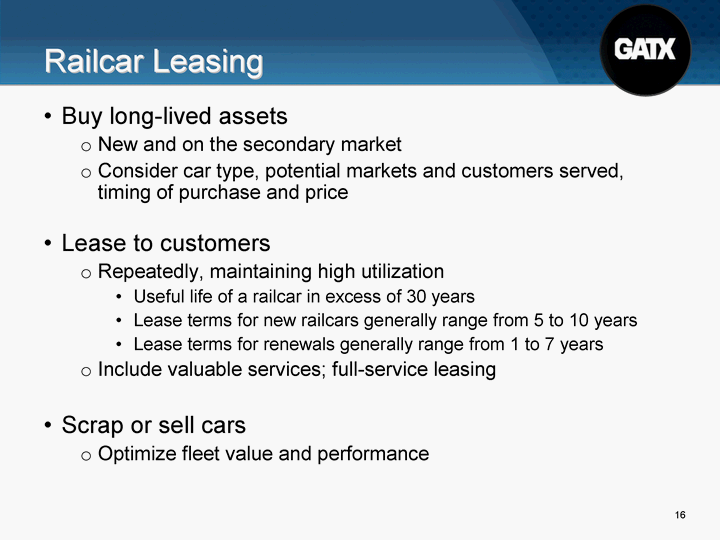
| Railcar Leasing Buy long-lived assets New and on the secondary market Consider car type, potential markets and customers served, timing of purchase and price Lease to customers Repeatedly, maintaining high utilization Useful life of a railcar in excess of 30 years Lease terms for new railcars generally range from 5 to 10 years Lease terms for renewals generally range from 1 to 7 years Include valuable services; full-service leasing Scrap or sell cars Optimize fleet value and performance 16 |
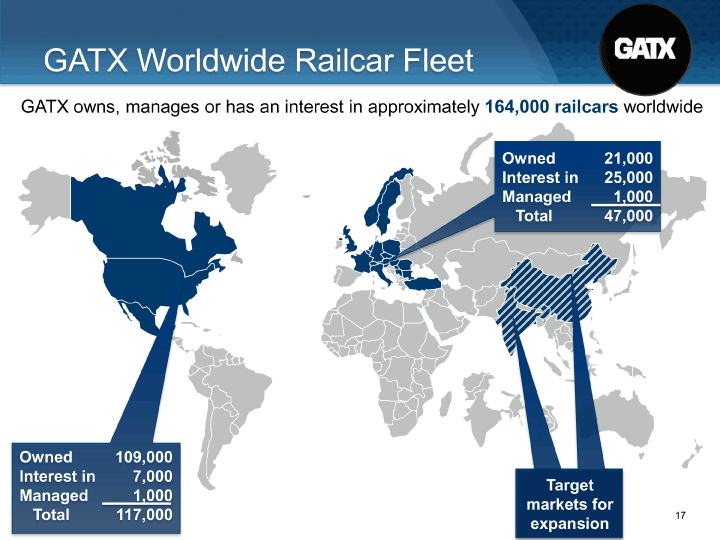
| Owned 109,000 Interest in 7,000 Managed 1,000 Total 117,000 Owned 21,000 Interest in 25,000 Managed 1,000 Total 47,000 Target markets for expansion GATX owns, manages or has an interest in approximately 164,000 railcars worldwide 17 GATX Worldwide Railcar Fleet |

| GATX Worldwide Railcar Fleet 18 Approximately 130,000 wholly-owned railcars as of 12/31/11 Based on 2011 Rail revenues approximately $966 million General Service Tank Cars 50% High Pressure Tank Cars 10% Specialty Covered Hoppers 11% Open Top Hoppers & Gondolas 10% Other 14% |

| GATX Fleet Major Car Types, Industries and Commodities 19 General Service Tank Cars High Pressure Tank Cars Specialty Covered Hoppers Gravity Covered Hoppers Gondolas Open Top Hoppers Chemical Chemical Plastics Agriculture Energy Energy Petroleum Petroleum Food Industrial Construction Construction Food Industrial Energy Steel Steel Agriculture Energy Construction Waste/Recycling Forest Products Construction Forest Products Waste/Recycling Acids (Sulfuric, Hydrochloric, etc.) Liquefied Petroleum Gas (LPG) High Density Polyethylene (PE) Grain Products Coal Coal Fertilizers and Fertilizer Ingredients Vinyl Chloride Monomer (VCM) Polyethylene Terephthalate (PET) Solid Fertilizer Petroleum Coke Aggregates Lubricating Oils Propylene Polypropylene Sand Metallurgical Coke Woodchips Edible Oils and Syrups Polyvinyl Chloride Cement Aggregates Petroleum Coke Asphalt Sugar Fly Ash Woodchips Metallurgical Coke Fuel Oil Flour Roofing Granules Industrial Minerals Industrial Minerals Biofuels Cement Minerals Scrap Metal Taconite Chemicals (Sodium Hydroxide, Styrene, etc.) Fly Ash Solid Waste Industries Served Typical Commodities |

| Rail Worldwide Top Customers 20 Rail has a diverse customer base with over 900 customers worldwide Top 20 Customer Families: Revenue Contribution as % of Total Revenue Top 50 Customer Families Customer families sometimes include more than one customer account, therefore the S&P or equivalent ratings noted generally reflect the credit quality of the rated parent entity. Lease obligations of subsidiaries are not necessarily guaranteed by the rated parent entity. Not rated/ Private 26% |

| Rail Customer Stability 21 Date of the first lease contract for each of GATX's top ten worldwide customers in 2011: Customer # Year Relationship Initiated 1 1960 2 1937 3 1969 4 1946 5 1958 6 1963 7 1977 8 1950 9 1976 10 1958 GATX's commitment to the industry and extensive experience has led to stable and long-standing customer relationships that serve as the backbone of our business Customers demand that their railcar provider be committed to providing excellent service, possess a breadth and depth of knowledge, and that they be responsive and flexible The average relationship tenure among this group is 53 years Top customers based on total revenues; reflects current/predecessor companies |

| Rail North American Customer Base 22 Rank S&P Credit Rating % of Revenue 1 A 3.6% 2 BBB+ 3.0% 3 A- 2.1% 4 BBB+ 2.1% 5 BB+ 2.0% 6 BB+ 2.0% 7 A+ 1.8% 8 A+ 1.8% 9 NR 1.6% 10 A 1.6% 11 NR 1.5% 12 BBB 1.4% 13 BBB 1.4% 14 BB 1.2% 15 A- 1.1% 16 BBB+ 1.1% 17 AA- 1.0% 18 A 1.0% 19 NR 0.9% 20 A 0.8% Top 20 Customer Families Average Remaining Lease Term Average remaining lease term is approximately four years In 2012, leases on approximately 20,000 railcars are scheduled for renewal Leases are typically fixed rate, paid monthly Customer families sometimes include more than one customer account, therefore the S&P or equivalent ratings noted generally reflect the credit quality of the rated parent entity. Lease obligations of subsidiaries are not necessarily guaranteed by the rated parent entity. |

| Experienced Through Business Cycles North American Rail 23 GATX used the up market (2004 - 2008) to prepare for the downturn GATX kept railcars on lease throughout the downturn GATX increased lease rates in 2011 while maintaining high utilization GATX North American Fleet Utilization 95% 90% 99% 96% 98% |

| GATX Effectively Manages the Economic Cycle North American Fleet 24 Extended renewal terms during the peak of the market to capture high lease rates and reduce cars exposed during the downturn Shortened renewal terms in weaker pricing environment |

| Market Environment North American Rail 25 The GATX Lease Price Index ("LPI") is an internally generated business indicator that measures general lease rate pricing on renewals within Rail's North American railcar fleet The LPI reflects the weighted average lease rate for a select group of railcar types that GATX believes to be representative of its overall North American fleet The LPI renewal rate change measures the percentage change between the weighted average renewal lease rate and the weighted average expiring lease rate LPI Renewal Rate Change LPI Renewal Rate Change 2006 16.8% 2007 13.5% 2008 5.2% 2009 -11.0% 2010 -15.8% 2011 6.9% |

| Locomotive Group 26 GATX owns, manages or has an interest in approximately 660 locomotives in North America GATX focuses on high-quality EMD four-axle locomotives GATX leases locomotives to Class I, regional and short-line railroads and industrial users Many leases include maintenance services which improve equipment reliability as of 12/31/11 Locomotives Owned 572 Interest In 50 Managed 40 Total 662 |

| GATX Rail Europe 27 Approximately 85,000 tank cars Approximately 75,000 freight cars AAE 37.5% owned; freight cars Approximately 25,000 railcars GRE 100% owned; tank cars Approximately 21,000 railcars * GATX management estimate About 750,000 total railcars in Europe Transwaggon & VTG 25% |

| GATX Rail Europe 28 Length of leases tend to be shorter than in the U.S., but renewal success rate is high Average remaining lease term is approximately two years Fleet utilization and renewal rates have remained relatively stable |

| GATX Rail Europe 29 Products Carried in Tank Cars Based on 2011 revenues of wholly-owned fleet Based on # of wholly-owned railcars at 12/31/11 * Mineral Oil refers to light and dark petroleum products. Poland 25% Austria 12% Hungary 6% Switzerland 4% Czech Republic 3% Other 7% Germany 39% Romania 4% Mineral Oil* 71% Chemical 11% LPG 11% Other 7% |

| Full-Service Leasing GATX has built and maintained a strong market position by focusing on full-service leasing GATX provides the expertise, knowledge and services essential to our customers Maintenance Engineering Training 30 |

| Rail Maintenance Network Maintaining railcars and locomotives is necessary and complicated Customers rely on GATX to manage the maintenance process In North America, GATX owns a network of Six full-scale maintenance facilities Two field repair centers Six customer site locations Three fast-track service centers Twenty mobile service units GATX also works with preferred third-party service providers In 2011, GATX performed an aggregate of 83,000 service events in its owned and third-party maintenance network in North America In Europe, GATX has major service centers in Germany and Poland as well as a customer site location in Poland 31 |

| Rail Maintenance Services 32 GATX handles every aspect of railcar maintenance, from routine service to complex railcar overhauls and retrofits GATX utilizes the latest in railcar maintenance equipment technology, including non-destructive testing inspection equipment, high-capacity overhead crane systems, environmentally-compliant paint spray, and closed loop cleaning systems Sample services include: Regulatory compliance work Rebuilds Lining repairs Safety valve/coil testing Air brake system maintenance Insulation inspection |

| Rail Engineering 33 GATX's rail engineering team, comprised of experienced mechanical, structural, and chemical engineers, is constantly communicating with the customer base Each customer faces a unique set of transportation challenges. Railcar needs change based on factors such as a customer's commodity focus or the location and layout of their manufacturing facilities GATX's engineers draw on decades of experience to identify solutions that are tailored for each customer |

| Training 34 Signing a full-service lease is the starting point for GATX's long-term relationships with its customers GATX's service offering goes beyond maintenance and engineering to include ongoing training for customers. Since customers are the operators of the railcars, they need to be well-versed in the equipment and related regulations GATX offers rail customer training, both at Company headquarters and through its "TankTrainer" mobile classroom. This rolling classroom is in use year-round at customer facilities across North America |

| 2012 Rail Market Environment North American rail market continues to improve Rail traffic recovered from the low point, but has not achieved prior peak levels Industry-wide idle railcar inventory has declined Idle inventory reached over 500,000 railcars in 2009 There are now about 290,000 idle railcars GATX North American fleet utilization is over 98% Lease rate environment is favorable European rail market mixed Tank car market historically less volatile GATX Rail Europe fleet utilization is over 97% GRE is achieving incremental lease rate increases Freight car market recovering at a slow pace 35 |

| American Steamship Company |

| American Steamship Company ("ASC") 37 ASC provides transportation of dry-bulk commodities on the Great Lakes including iron ore, coal, and limestone aggregates ASC has been operating on the Great Lakes for more than 100 years, joining GATX in 1973 Fleet of 18 self-unloading vessels Composition of fleet enhances ability to meet varying levels of demand on the Great Lakes Range in length from 635 feet to 1,000 feet Single trip vessel carrying capacity ranges from 23,800 to 80,900 gross tons Unloading speeds range from 7,000 to 10,000 net tons per hour No shore side assistance required; can operate 24 hours a day, seven days a week |

| ASC Market 38 U.S.-Flag Dry-Bulk Cargo Carriage (1) Capacity of U.S.-Flag Vessel Operators Industry Total Annual Capacity (2) 106 Million Net Tons Steel mills are the largest consumers of cargos carried by U.S.-flagged Great Lakes vessels The Great Lakes states account for more than 80% of the nation's BOF steelmaking capacity Coal is transported to power generating facilities along four of the Great Lakes Limestone is used by the steel and construction industries Source: Lake Carriers' Association GATX management estimate Interlake Steamship Company 23% Grand River Navigation 11% Central Marine Logistics 7% |
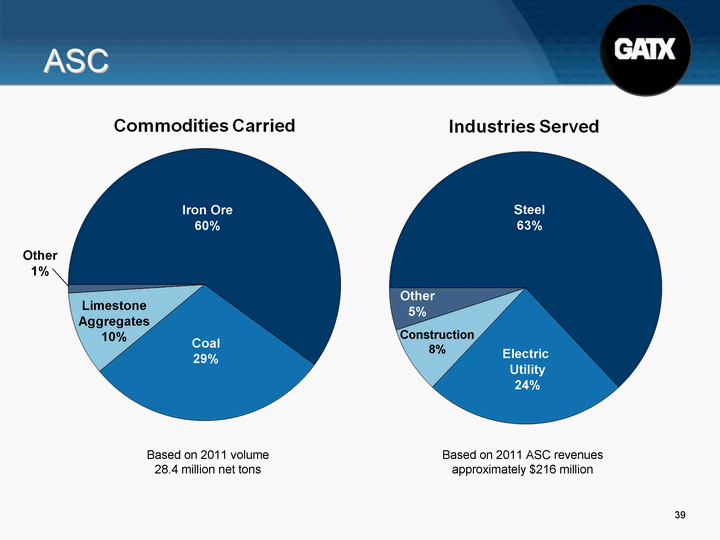
| ASC 39 Based on 2011 volume 28.4 million net tons Iron Ore 60% Coal 29% Limestone Aggregates 10% Other 1% Steel 63% Electric Utility 24% Construction 8% Other 5% Based on 2011 ASC revenues approximately $216 million |

| ASC Industry Overview 40 Industry is mature The assets are long-lived High barriers to entry Asset costs have risen sharply in recent years In 2012, ASC will deploy the first new vessel on the Great Lakes in 12 years Customer base is highly concentrated Top five customers comprised 86% of ASC's total revenue in 2011 Market is primarily driven by integrated steel producers Sailing season generally runs from late March through December 31st |

| ASC Great Lakes Trade Patterns 41 IRON ORE PELLETS Routes and Loading Ports LIMESTONE Routes and Loading Ports EASTERN COAL Routes and Loading Ports WESTERN COAL Routes and Loading Ports |

| 42 With the most versatile fleet operating on the Great Lakes, ASC is well positioned to manage its fleet to meet changing demand levels ASC Fleet |

| Portfolio Management |

| Portfolio Management 44 Owned Portfolio Portfolio Management seeks to: Maximize the value of existing owned and administered portfolios joint ventures Invest selectively in domestic marine and container-related assets Joint Ventures: Aircraft Engine Leasing: venture with Rolls-Royce is one of the largest spare aircraft engine portfolios in the industry Marine: co-investments with blue-water shipping pool operators Portfolio Administration - expertise in Portfolio and Equipment Management Assets managed for third-party owners $847 million NBV (on and off balance sheet assets) as of 12/31/11 See the Appendix for a reconciliation of non-GAAP measures |

| Portfolio Management Rolls-Royce and Partners Finance ("RRPF") 45 RRPF was established in 1989 as a joint venture by Rolls-Royce plc; GATX became 50/50 partner in 1998 RRPF leases spare aircraft engines to Rolls-Royce plc and commercial airlines One of the largest spare aircraft engine portfolios in the industry, with approximately 370 engines Based on NBV as of 1/31/12 A320 B777 A340 - 500/600 A380 |

| Portfolio Management Marine Joint Ventures 46 JV Name Partner Partner Fleet Approximate Total Number of Vessels GATX Investment Focus Vessel Type JV Number of Vessels Clipper Third Clipper Group 200 Bulk Carriers 2 Cardinal Marine IMC Corp. 50 Chemical Parcel Tankers 6 Somargas/Singco I.M. Skaugen 40 LPG/E/Multi-gas Carriers 10 Partners are leading ship owners and operators with extensive shipping experience, reputations for outstanding service, and shared investment philosophy Our jointly-owned vessels are a small part of the overall pool of vessels operated by our partners Investments generally made at historically attractive vessel costs Clipper Fourth joint venture, consisting of 14 handy-size chemical parcel tankers, was dissolved in 2011 GATX retained 6 of the vessels |

| Portfolio Management Administered Portfolio 47 GATX leverages its asset expertise and infrastructure by managing portfolios of assets for third-party owners Activities include re-leasing initiatives, asset sales, advisory services, and back-office functions GATX is paid a management fee and typically retains a "residual interest" when an asset is sold; the higher the sale price, the greater the gain for GATX GATX has no investment in the administered portfolio $168 million NBV as of 12/31/11 |

| Financial Highlights |
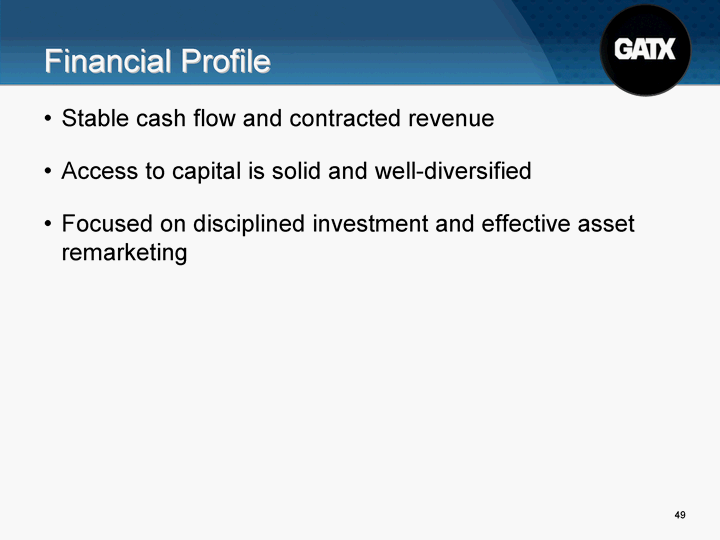
| Financial Profile Stable cash flow and contracted revenue Access to capital is solid and well-diversified Focused on disciplined investment and effective asset remarketing 49 |
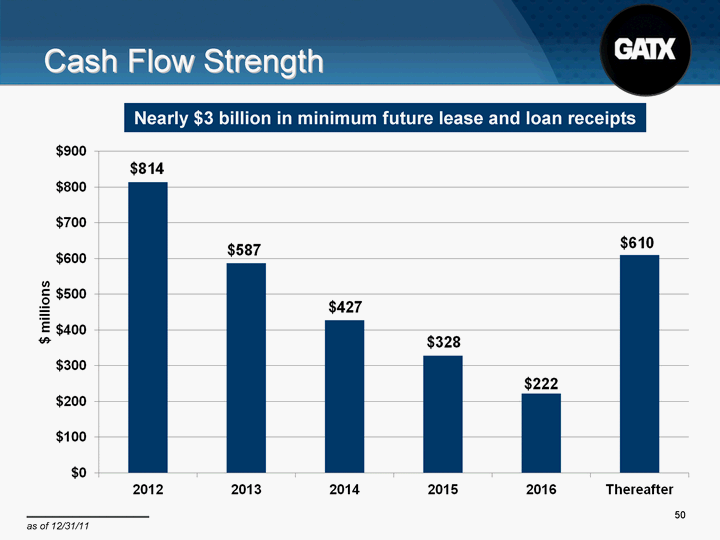
| Cash Flow Strength 50 Nearly $3 billion in minimum future lease and loan receipts as of 12/31/11 |

| Operating Cash Flow and Portfolio Proceeds 51 Strong Operating Cash Flow and Portfolio Proceeds Continuing operations |

| Financial Profile Future Debt Obligations 52 GATX's debt maturity schedule is moderate and manageable as of 12/31/11 |
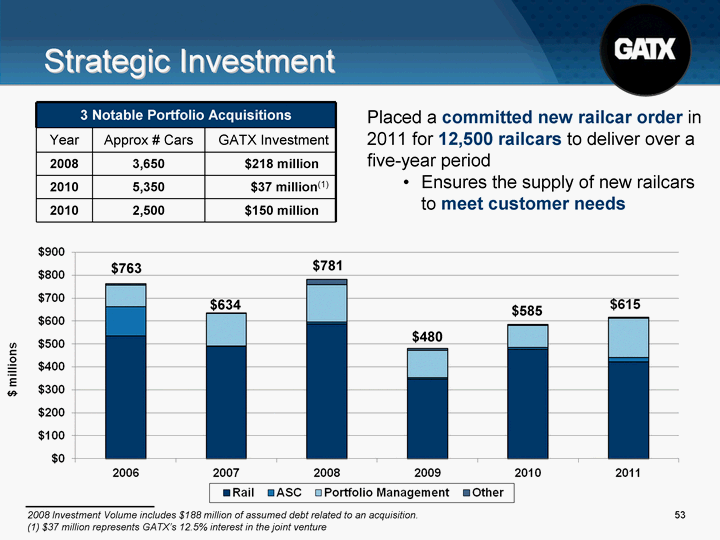
| Strategic Investment 53 3 Notable Portfolio Acquisitions 3 Notable Portfolio Acquisitions 3 Notable Portfolio Acquisitions Year Approx # Cars GATX Investment 2008 3,650 $218 million 2010 5,350 $37 million(1) 2010 2,500 $150 million 2008 Investment Volume includes $188 million of assumed debt related to an acquisition. (1) $37 million represents GATX's 12.5% interest in the joint venture Placed a committed new railcar order in 2011 for 12,500 railcars to deliver over a five-year period Ensures the supply of new railcars to meet customer needs $763 $634 $781 $480 $585 |

| Strong Balance Sheet 54 Total Recourse Debt = On Balance Sheet Recourse Debt + Off Balance Sheet Recourse Debt + Capital Lease Obligations + Commercial Paper and Bank Credit Facilities, Net of Unrestricted Cash |

| Financial Performance 55 EPS and ROE exclude Tax Benefits and Other Items. See the Appendix for a reconciliation of these non-GAAP measures. 2012 Forecast is based on management's January 2012 EPS guidance of a range of $2.40 to $2.60 per diluted share. |

| Long-term Outlook Very optimistic ... GATX has a strong competitive position Strategic investment Acquired an interest in over 18,000 railcars during market downturn at attractive valuations Placed GATX's largest new railcar order Opportunities for growth Additional tank car investment in Europe is attractive Emerging rail leasing markets present high potential GATX has excellent access to attractively priced capital GATX will continue its focus on operational efficiencies within the rail maintenance network and at ASC 56 |

| Summary and Opportunity GATX has consistently been a market force for 114 years GATX prepared for and capitalized on the market downturn GATX is benefitting from the rail market recovery GATX has the capacity and desire to invest in quality, long-lived assets GATX is focused on generating attractive, risk-adjusted returns 57 |

| Appendix Reconciliation of non-GAAP measures |

| Reconciliation of non-GAAP measures 59 |

| Reconciliation of non-GAAP measures 60 |

| GATX Corporation Financial Review For detailed financial information, please see the SUPPLEMENTAL FINANCIAL INFORMATION contained in the Investor Relations section of www.gatx.com. |
